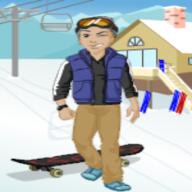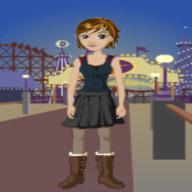的生平~~英文
急~20分
詳細D
Ples~
達文西的生平
2007-07-24 11:04 pm
回答 (3)
2007-07-24 11:12 pm
✔ 最佳答案
Leonardo di ser Piero da Vinci(pronounciation (help·info)), April 15, 1452 – May 2, 1519) was an Italian polymath: scientist, mathematician, engineer, inventor, anatomist, painter, sculptor, architect, musician, and writer.The illegitimate son of a notary, Messer Piero, and a peasant girl, Caterina, Leonardo had no surname in the modern sense, "da Vinci" simply meaning "of Vinci": his full birth name was "Leonardo di ser Piero da Vinci", meaning "Leonardo, son of (Mes)ser Piero from Vinci."
Leonardo has often been described as the archetype of the "Renaissance man", a man whose seemingly infinite curiosity was equalled only by his powers of invention. He is widely considered to be one of the greatest painters of all time and perhaps the most diversely talented person ever to have lived.[2]
It is primarily as a painter that Leonardo was and is renowned. Two of his works, the Mona Lisa and The Last Supper occupy unique positions as the most famous, most reproduced and most imitated portrait and religious painting of all time, their fame approached only by Michelangelo's Creation of Adam. Leonardo's drawing of the Vitruvian Man is also iconic. Perhaps fifteen paintings survive, the small number due to his constant, and frequently disastrous, experimentation with new techniques, and his chronic procrastination.[3] Nevertheless these few works, together with his notebooks, which contain drawings, scientific diagrams, and his thoughts on the nature of painting, comprise an unmatched contribution to later generations of artists.
As an engineer, Leonardo conceived ideas vastly ahead of his own time, conceptualising a helicopter, a tank, concentrated solar power, a calculator, and the double hull, and outlining a rudimentary theory of plate tectonics. Relatively few of his designs were constructed or even feasible during his lifetime,[4] but some of his smaller inventions such as an automated bobbin winder and a machine for testing the tensile strength of wire entered the world of manufacturing unheralded. As a scientist, he greatly advanced the state of knowledge in the fields of anatomy, civil engineering, optics, and hydrodynamics.
Contents[hide]
1 Biography
1.1 Early life, 1452–1466
1.2 Verrocchio's workshop, 1466–1476
1.3 Professional life, 1476–1519
1.4 Old age
1.5 Relationships and influences
1.5.1 Florence — Leonardo's artistic and social background
1.5.2 Assistants and pupils
1.5.3 Personal life
2 Leonardo’s painting
2.1 Early works
2.2 Paintings of the 1480s
2.3 Paintings of the 1490s
2.4 Paintings of the 1500s
2.5 Leonardo's drawings
3 Leonardo as observer, scientist and inventor
3.1 Journals
3.2 Scientific studies
3.3 Anatomy
3.4 Engineering and inventions
4 Leonardo, the "Legend"
4.1 Vasari's "Lives"
4.2 On Leonardo's genius
5 List of Leonardo's paintings
5.1 Entirely by Leonardo
5.2 Leonardo with other hands
5.3 Accepted attributions
5.4 Attribution depedent upon each other
5.5 Disputed
5.6 Recent attribution
5.7 Known only as a copy
6 See also
7 Notes
8 References
9 Further reading
10 External links
2007-07-24 11:30 pm
Leonardo da Vinci
Leonardo di ser Piero da Vinci(pronounciation (help·info)), April 15, 1452 – May 2, 1519) was an Italian polymath: scientist, mathematician, engineer, inventor, anatomist, painter, sculptor, architect, musician, and writer.
The illegitimate son of a notary, Messer Piero, and a peasant girl, Caterina, Leonardo had no surname in the modern sense, "da Vinci" simply meaning "of Vinci": his full birth name was "Leonardo di ser Piero da Vinci", meaning "Leonardo, son of (Mes)ser Piero from Vinci."
Leonardo has often been described as the archetype of the "Renaissance man", a man whose seemingly infinite curiosity was equalled only by his powers of invention. He is widely considered to be one of the greatest painters of all time and perhaps the most diversely talented person ever to have lived.[2]
It is primarily as a painter that Leonardo was and is renowned. Two of his works, the Mona Lisa and The Last Supper occupy unique positions as the most famous, most reproduced and most imitated portrait and religious painting of all time, their fame approached only by Michelangelo's Creation of Adam. Leonardo's drawing of the Vitruvian Man is also iconic. Perhaps fifteen paintings survive, the small number due to his constant, and frequently disastrous, experimentation with new techniques, and his chronic procrastination.[3] Nevertheless these few works, together with his notebooks, which contain drawings, scientific diagrams, and his thoughts on the nature of painting, comprise an unmatched contribution to later generations of artists.
As an engineer, Leonardo conceived ideas vastly ahead of his own time, conceptualising a helicopter, a tank, concentrated solar power, a calculator, and the double hull, and outlining a rudimentary theory of plate tectonics. Relatively few of his designs were constructed or even feasible during his lifetime,[4] but some of his smaller inventions such as an automated bobbin winder and a machine for testing the tensile strength of wire entered the world of manufacturing unheralded. As a scientist, he greatly advanced the state of knowledge in the fields of anatomy, civil engineering, optics, and hydrodynamics.
Early life, 1452–1466
Leonardo was born on April 15, 1452, at Anchiano, a hamlet near the Tuscan hill town of Vinci, in the lower valley of the Arno River in the territory of Florence. He was the illegitimate son of Ser Piero da Vinci, a Florentine notary, and Caterina, a peasant. Little is known about his early life, which has been the subject of historical conjecture by Vasari and others. [5] [6]
Leonardo was later to record only two incidents of his childhood. One, which he regarded as an omen, was when a hawk dropped from the sky and hovered over his cradle, its tail feathers brushing his face.[7]
Leonardo's earliest known drawing, the Arno Valley, 1473.The second incident occurred while he was exploring in the mountains. He discovered a cave and recorded his emotions at being, on one hand, terrified that some great monster might lurk there and on the other, driven by curiosity to find out what was inside.
At the age of five, he went to live in the household of his father, grandparents and uncle, Francesco, in the small town of Vinci, where his father had married a sixteen-year-old girl named Albiera, who loved Leonardo but unfortunately died young.
Vasari, the 16th century biographer of Renaissance painters, tells the story of how a local peasant requested that Ser Piero ask his talented son to paint a picture on a round plaque. Leonardo responded with a painting of snakes spitting fire which was so terrifying that Ser Piero sold it to a Florentine art dealer, who sold it to the Duke of Milan. Meanwhile, having made a profit, Ser Piero bought a plaque decorated with a heart pierced by an arrow which he gave to the peasant.
Leonardo di ser Piero da Vinci(pronounciation (help·info)), April 15, 1452 – May 2, 1519) was an Italian polymath: scientist, mathematician, engineer, inventor, anatomist, painter, sculptor, architect, musician, and writer.
The illegitimate son of a notary, Messer Piero, and a peasant girl, Caterina, Leonardo had no surname in the modern sense, "da Vinci" simply meaning "of Vinci": his full birth name was "Leonardo di ser Piero da Vinci", meaning "Leonardo, son of (Mes)ser Piero from Vinci."
Leonardo has often been described as the archetype of the "Renaissance man", a man whose seemingly infinite curiosity was equalled only by his powers of invention. He is widely considered to be one of the greatest painters of all time and perhaps the most diversely talented person ever to have lived.[2]
It is primarily as a painter that Leonardo was and is renowned. Two of his works, the Mona Lisa and The Last Supper occupy unique positions as the most famous, most reproduced and most imitated portrait and religious painting of all time, their fame approached only by Michelangelo's Creation of Adam. Leonardo's drawing of the Vitruvian Man is also iconic. Perhaps fifteen paintings survive, the small number due to his constant, and frequently disastrous, experimentation with new techniques, and his chronic procrastination.[3] Nevertheless these few works, together with his notebooks, which contain drawings, scientific diagrams, and his thoughts on the nature of painting, comprise an unmatched contribution to later generations of artists.
As an engineer, Leonardo conceived ideas vastly ahead of his own time, conceptualising a helicopter, a tank, concentrated solar power, a calculator, and the double hull, and outlining a rudimentary theory of plate tectonics. Relatively few of his designs were constructed or even feasible during his lifetime,[4] but some of his smaller inventions such as an automated bobbin winder and a machine for testing the tensile strength of wire entered the world of manufacturing unheralded. As a scientist, he greatly advanced the state of knowledge in the fields of anatomy, civil engineering, optics, and hydrodynamics.
Early life, 1452–1466
Leonardo was born on April 15, 1452, at Anchiano, a hamlet near the Tuscan hill town of Vinci, in the lower valley of the Arno River in the territory of Florence. He was the illegitimate son of Ser Piero da Vinci, a Florentine notary, and Caterina, a peasant. Little is known about his early life, which has been the subject of historical conjecture by Vasari and others. [5] [6]
Leonardo was later to record only two incidents of his childhood. One, which he regarded as an omen, was when a hawk dropped from the sky and hovered over his cradle, its tail feathers brushing his face.[7]
Leonardo's earliest known drawing, the Arno Valley, 1473.The second incident occurred while he was exploring in the mountains. He discovered a cave and recorded his emotions at being, on one hand, terrified that some great monster might lurk there and on the other, driven by curiosity to find out what was inside.
At the age of five, he went to live in the household of his father, grandparents and uncle, Francesco, in the small town of Vinci, where his father had married a sixteen-year-old girl named Albiera, who loved Leonardo but unfortunately died young.
Vasari, the 16th century biographer of Renaissance painters, tells the story of how a local peasant requested that Ser Piero ask his talented son to paint a picture on a round plaque. Leonardo responded with a painting of snakes spitting fire which was so terrifying that Ser Piero sold it to a Florentine art dealer, who sold it to the Duke of Milan. Meanwhile, having made a profit, Ser Piero bought a plaque decorated with a heart pierced by an arrow which he gave to the peasant.
2007-07-24 11:25 pm
達文西Leonardo da Vinci,生於1452年,母親是平凡的農家女子,父親是律師。因為父親的關係,達文西從小即接受到良好的學校教育,能夠彈奏樂器,唱歌,喜歡數學研究,也展現了繪畫的才能。十四歲左右,父親把他帶到佛羅倫斯的維洛及歐(Verrochio)畫室學畫。很快的,達文西的天份就讓他青出於藍,在繪畫上展現超人的技巧與獨特風格。
不過成名後的達文西卻與當時的藝術市場和贊助藝術家的富賈不和,終因倔強之故惹惱了麥迪奇(the Medicis)家族,改往米蘭宮廷發展。在米蘭的十六年當中(除了少數小型的肖像畫之外)最多只接了兩件大型的委託計劃:〈最後的晚餐〉和為史佛薩所作的騎馬雕像。他也在向普瑞迪斯(Predis)兄弟轉包之下畫了〈岩窟的聖母〉。 因此達文西生平留下來的畫作並不多。
晚年的達文西法國國王法蘭西斯一世的邀請到了法國,博學的達文西唯一的工作就是陪皇帝聊天,當然也因為移居法國的緣故,『蒙娜麗莎的微笑』也被他隨身攜到了法國境內,最後這幅名畫在19世紀時被拿破崙安置於羅浮宮內,這才有了小說的開始… 。
達文西年表
1452 達文西生於佛羅倫斯附近的文西鎮。
1469 進入佛羅倫斯藝術家安德利亞‧德爾‧維洛及歐(Andrea del Verrocchio)工作室學藝,從此展開其藝術生涯。
1471 維洛及歐工作室為佛羅倫斯大教堂(Florence Cathedral)的頂小亭裝置一座金球。
1472 達文西加入佛羅倫斯畫家公會。
1475 達文西發表初期創作。
1476 達文西被控以同性戀罪行,被宣告無罪。
1478 著手進行大西洋手稿。
1482 遷居米蘭,服務於米蘭公爵盧多維哥‧史佛薩旗下,並創立達文西學院。
1483 受託完成《岩間聖母》。
1490 根據維特魯威(Vitruvius)之理論作人體比例圖:《維特魯威人》。
1493 潛心製作史佛薩騎馬銅像的各式習作與模型。
1495~97 為米蘭聖母感恩堂之膳食堂繪製濕壁畫《最後的晚餐》。
1499 進行橋樑之研究。
1500 達文西歸返佛羅倫斯,並造訪羅馬。
1502 擔任教皇軍指揮官凱薩‧波吉亞(Cesare Borgia)的 軍事工程師。
1503 開始構思《蒙娜麗莎》。
1506~13 再度往訪米蘭(1506), 並接受教皇李奧十世的邀請前往羅馬。
1516 達文西到法國旅行,居住於安布瓦茲附近的 克盧城堡(Cloux)。繪《自畫像》。
1519 5月2日,達文西逝世於克盧城堡,享年六十七歲。
看《達文西密碼》裡的達文西作品
《岩間聖母》
此畫確實如小說中描述,是達文西為米蘭聖弗朗切斯科教堂的禮拜堂所作的祭壇畫,也因為一反常理的人物與動作安排,引發教會不滿,最後還因此打了場官司,以第二幅較為正統《岩間聖母》做為和解。(第二幅畫現藏于倫敦國立美術館,取名為《岩間的聖處女》)。這幅畫引起爭議的地方是在於畫面左方的嬰兒耶穌看起來是雙手作揖地謝謝畫面右方的嬰兒彼得。如此的書面已經完全出乎當時人們可以接受與想像的邏輯。不過依達文西對於宗教所抱持的懷疑態度,這樣的一個詮釋,倒是引起後來史學家們諸多的研究與討論。
此畫以文藝復興做經典的金字塔形位主要構圖,達文西最著名的繪畫技法”Sfumato”在這幅作品中營造出幽遠如夢境般的氣氛。
《維特魯威人》
《維特魯威人》是達文西按照一位古羅馬建築師,維特魯威﹝Vitruvius﹞所留下關於比例的學說,繪製出一個具完美比例的的人體圖像。這位古羅馬建築師和工程師維特魯威曾經寫下著名的《建築十書》,全書分為十卷,是現存最古老且最有影響的建築學專著。內容涉及城市規劃、建築設計基本原理、建築構圖原理、西方古典建築型制、建築環境控制、建築材料、市政設施、建築師的培養等等。
《最後的晚餐》
《最後的晚餐》是聖經圖像中最常見的一個畫面,描寫耶穌與十二門徒一起用餐,耶穌預告門徒中有人被判祂,祂將被逮捕,應驗宿命死在十字架上的結局。事實上「最後的晚餐」也是基督教的儀式之ㄧ,是保存至今的天主教「彌撒」的起源,教徒會在儀式中領受聖體(麵包),和聖血(紅酒)。
當達文西從1495年開始在米蘭多明尼加修道院的聖母感恩禮拜堂的餐廳繪製這幅巨作時,常常因為一整天對著空白的牆壁發呆,而引發公爵和修道院的不滿,認為達文西偷懶。事實上,達文西是在思考繪畫中最難描繪的層次-如何利用手勢與四肢動作來表現「人類靈魂的意圖」,在這幅畫中,達文西運用嚴謹而科學的透視技法,將每一條分割線都準確向三度景深的焦點集中(也就是以耶穌為中心點),耶穌攤開的雙手形成一個金字塔形,而十二門徒則三人成一組分列於耶穌左右,達文西運用人物的手勢、動作,巧妙的安排了畫面上下左右的律動,也在騷動的變化中闖造了靜定永恆的力量。
達文西也將他創新的實驗材料-蛋彩加油,運用在這幅畫作中,但沒想到卻造成了壁畫的提早衰敗,1536年義大利著名的傳記家瓦薩利到米蘭參觀這幅畫作時,壁畫早已斑駁不堪,十七世紀時,修道院甚至將牆壁打了一個洞,只為餐廳與廚房相通,而使畫作再度受損。
《蒙娜麗莎的微笑》
這幅畫堪稱世界上最著名的肖像畫。畫中人物雖然據傳記學家瓦薩利的記載,是弗羅倫斯望族吉奧孔達(Francesco del Gioconda)的妻子麗莎,不過後人卻對她有更多的遐想與猜測,甚至認為這幅畫是達文西自己的自畫像!也許是這位畫中完美的女性形象,直視觀畫者的眼神,與不可思議的淡淡微笑,讓蒙娜麗莎充滿神秘卻又吸引人的魔力!再加上畫作輕霧般(Sfumato)的朦朧處理,背後山水左右水平線的不對稱,更是為世人所臆測,是否達文西在畫中隱藏了什麼深遠意涵?尤其這幅畫在達文西晚年一直隨身攜帶在身邊,並沒有交付給所託的業主,讓蒙娜麗莎的微笑又增添了另一個謎……。
圖:《蒙娜麗莎的微笑》
建議書單: ‧ 7 Brains-怎樣擁有達文西的七種天才 ‧ 不斷探索的達文西:科學與藝術的先行者 ‧ 文藝復興:從黑暗中誕生的黃金年代
‧ 藝術裡的秘密:100個藝術名作的傳世之謎 ‧
世界十大博物館與名畫(共二十冊)
‧ 印象花園8達文西
‧ 西洋名畫家達文西 ‧ 佛羅倫斯水悠悠 ‧ 神秘的微笑—達文西
‧ 追蹤達文西的腳印 ‧ 義大利文藝復興的宮廷藝術 ‧ 達文西
‧ 達文西 ‧ 達文西 DVD ‧ 達文西:科學與藝術天才
‧ 達文西-科學第一人 ‧ 達芬奇寓言的智慧 ‧ 像藝術家一樣思考
‧ 漫畫達芬奇 ‧ 蒙娜麗莎五百年 ‧ 蒙娜麗莎的秘密-人生不可錯過的世界名畫
不過成名後的達文西卻與當時的藝術市場和贊助藝術家的富賈不和,終因倔強之故惹惱了麥迪奇(the Medicis)家族,改往米蘭宮廷發展。在米蘭的十六年當中(除了少數小型的肖像畫之外)最多只接了兩件大型的委託計劃:〈最後的晚餐〉和為史佛薩所作的騎馬雕像。他也在向普瑞迪斯(Predis)兄弟轉包之下畫了〈岩窟的聖母〉。 因此達文西生平留下來的畫作並不多。
晚年的達文西法國國王法蘭西斯一世的邀請到了法國,博學的達文西唯一的工作就是陪皇帝聊天,當然也因為移居法國的緣故,『蒙娜麗莎的微笑』也被他隨身攜到了法國境內,最後這幅名畫在19世紀時被拿破崙安置於羅浮宮內,這才有了小說的開始… 。
達文西年表
1452 達文西生於佛羅倫斯附近的文西鎮。
1469 進入佛羅倫斯藝術家安德利亞‧德爾‧維洛及歐(Andrea del Verrocchio)工作室學藝,從此展開其藝術生涯。
1471 維洛及歐工作室為佛羅倫斯大教堂(Florence Cathedral)的頂小亭裝置一座金球。
1472 達文西加入佛羅倫斯畫家公會。
1475 達文西發表初期創作。
1476 達文西被控以同性戀罪行,被宣告無罪。
1478 著手進行大西洋手稿。
1482 遷居米蘭,服務於米蘭公爵盧多維哥‧史佛薩旗下,並創立達文西學院。
1483 受託完成《岩間聖母》。
1490 根據維特魯威(Vitruvius)之理論作人體比例圖:《維特魯威人》。
1493 潛心製作史佛薩騎馬銅像的各式習作與模型。
1495~97 為米蘭聖母感恩堂之膳食堂繪製濕壁畫《最後的晚餐》。
1499 進行橋樑之研究。
1500 達文西歸返佛羅倫斯,並造訪羅馬。
1502 擔任教皇軍指揮官凱薩‧波吉亞(Cesare Borgia)的 軍事工程師。
1503 開始構思《蒙娜麗莎》。
1506~13 再度往訪米蘭(1506), 並接受教皇李奧十世的邀請前往羅馬。
1516 達文西到法國旅行,居住於安布瓦茲附近的 克盧城堡(Cloux)。繪《自畫像》。
1519 5月2日,達文西逝世於克盧城堡,享年六十七歲。
看《達文西密碼》裡的達文西作品
《岩間聖母》
此畫確實如小說中描述,是達文西為米蘭聖弗朗切斯科教堂的禮拜堂所作的祭壇畫,也因為一反常理的人物與動作安排,引發教會不滿,最後還因此打了場官司,以第二幅較為正統《岩間聖母》做為和解。(第二幅畫現藏于倫敦國立美術館,取名為《岩間的聖處女》)。這幅畫引起爭議的地方是在於畫面左方的嬰兒耶穌看起來是雙手作揖地謝謝畫面右方的嬰兒彼得。如此的書面已經完全出乎當時人們可以接受與想像的邏輯。不過依達文西對於宗教所抱持的懷疑態度,這樣的一個詮釋,倒是引起後來史學家們諸多的研究與討論。
此畫以文藝復興做經典的金字塔形位主要構圖,達文西最著名的繪畫技法”Sfumato”在這幅作品中營造出幽遠如夢境般的氣氛。
《維特魯威人》
《維特魯威人》是達文西按照一位古羅馬建築師,維特魯威﹝Vitruvius﹞所留下關於比例的學說,繪製出一個具完美比例的的人體圖像。這位古羅馬建築師和工程師維特魯威曾經寫下著名的《建築十書》,全書分為十卷,是現存最古老且最有影響的建築學專著。內容涉及城市規劃、建築設計基本原理、建築構圖原理、西方古典建築型制、建築環境控制、建築材料、市政設施、建築師的培養等等。
《最後的晚餐》
《最後的晚餐》是聖經圖像中最常見的一個畫面,描寫耶穌與十二門徒一起用餐,耶穌預告門徒中有人被判祂,祂將被逮捕,應驗宿命死在十字架上的結局。事實上「最後的晚餐」也是基督教的儀式之ㄧ,是保存至今的天主教「彌撒」的起源,教徒會在儀式中領受聖體(麵包),和聖血(紅酒)。
當達文西從1495年開始在米蘭多明尼加修道院的聖母感恩禮拜堂的餐廳繪製這幅巨作時,常常因為一整天對著空白的牆壁發呆,而引發公爵和修道院的不滿,認為達文西偷懶。事實上,達文西是在思考繪畫中最難描繪的層次-如何利用手勢與四肢動作來表現「人類靈魂的意圖」,在這幅畫中,達文西運用嚴謹而科學的透視技法,將每一條分割線都準確向三度景深的焦點集中(也就是以耶穌為中心點),耶穌攤開的雙手形成一個金字塔形,而十二門徒則三人成一組分列於耶穌左右,達文西運用人物的手勢、動作,巧妙的安排了畫面上下左右的律動,也在騷動的變化中闖造了靜定永恆的力量。
達文西也將他創新的實驗材料-蛋彩加油,運用在這幅畫作中,但沒想到卻造成了壁畫的提早衰敗,1536年義大利著名的傳記家瓦薩利到米蘭參觀這幅畫作時,壁畫早已斑駁不堪,十七世紀時,修道院甚至將牆壁打了一個洞,只為餐廳與廚房相通,而使畫作再度受損。
《蒙娜麗莎的微笑》
這幅畫堪稱世界上最著名的肖像畫。畫中人物雖然據傳記學家瓦薩利的記載,是弗羅倫斯望族吉奧孔達(Francesco del Gioconda)的妻子麗莎,不過後人卻對她有更多的遐想與猜測,甚至認為這幅畫是達文西自己的自畫像!也許是這位畫中完美的女性形象,直視觀畫者的眼神,與不可思議的淡淡微笑,讓蒙娜麗莎充滿神秘卻又吸引人的魔力!再加上畫作輕霧般(Sfumato)的朦朧處理,背後山水左右水平線的不對稱,更是為世人所臆測,是否達文西在畫中隱藏了什麼深遠意涵?尤其這幅畫在達文西晚年一直隨身攜帶在身邊,並沒有交付給所託的業主,讓蒙娜麗莎的微笑又增添了另一個謎……。
圖:《蒙娜麗莎的微笑》
建議書單: ‧ 7 Brains-怎樣擁有達文西的七種天才 ‧ 不斷探索的達文西:科學與藝術的先行者 ‧ 文藝復興:從黑暗中誕生的黃金年代
‧ 藝術裡的秘密:100個藝術名作的傳世之謎 ‧
世界十大博物館與名畫(共二十冊)
‧ 印象花園8達文西
‧ 西洋名畫家達文西 ‧ 佛羅倫斯水悠悠 ‧ 神秘的微笑—達文西
‧ 追蹤達文西的腳印 ‧ 義大利文藝復興的宮廷藝術 ‧ 達文西
‧ 達文西 ‧ 達文西 DVD ‧ 達文西:科學與藝術天才
‧ 達文西-科學第一人 ‧ 達芬奇寓言的智慧 ‧ 像藝術家一樣思考
‧ 漫畫達芬奇 ‧ 蒙娜麗莎五百年 ‧ 蒙娜麗莎的秘密-人生不可錯過的世界名畫
收錄日期: 2021-04-13 14:03:07
原文連結 [永久失效]:
https://hk.answers.yahoo.com/question/index?qid=20070724000051KK02499



